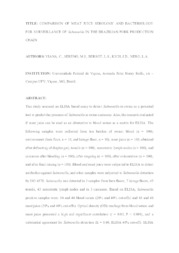Comparison of meat juice serology and bacteriology for surveillance of salmonella in the brazilian pork production chain.
Comparison of meat juice serology and bacteriology for surveillance of salmonella in the brazilian pork production chain.
Author(s): VIANA, C.; SERENO, M. J.; BERSOT, L. dos S; KICH, J. D.; NERO, L. A.
Publication year: 2020
Types of publication: Abstract in annals or event proceedings
Unit: Embrapa Swine & Poultry
Observation
Some of Embrapa's publications are published as ePub files. To read them, use or download one of the following free software options to your computer or mobile device. Android: Google Play Books; IOS: iBooks; Windows and Linux: Calibre.
Access other publications
Access the Agricultural Research Database (BDPA) to consult Embrapa's full library collection and records.
Visit Embrapa Bookstore to purchase books and other publications sold by Embrapa.

